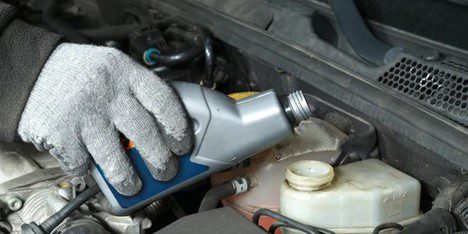Although brake fluid is one of the most important components of a vehicle, it is something that is sometimes neglected. There are different things to consider when maintaining your car, but checking your brake fluid should be at the top of your priority list. Without brake fluid, your braking system will not work correctly, meaning that there is nothing in place to stop your vehicle. Your brake fluid can have a profound impact on your braking, therefore it’s essential to understand what it is and why it’s needed.
If you’re a car owner looking for more information on brake fluid, you’ve come to the right place. In this blog from APD, we’ll discuss the purpose of brake fluid, the different types of brake fluid, and how to change it.

What is Brake Fluid?
Brake fluid is a vital component of any vehicle’s braking system. It is a hydraulic fluid that transfers force from the brake pedal to the calipers or drums to stop the car. It has a high boiling point and low compressibility, which allows it to withstand the high temperatures generated by the pads or drums. Without brake fluid, the pedal would be ineffective in stopping the vehicle. It also helps lubricate and protect the system’s internal components from corrosion and wear.
What does Brake fluid do?
As we have already mentioned, brake fluid is one of the most integral parts of your vehicle. Here are two reasons why brake fluid is important;
Helps to Stop Your Vehicle
The primary purpose of brake fluid is to help your vehicle’s braking system. Brake fluid is responsible for converting the mechanical force of pressing the brake pedal into hydraulic pressure, which then translates into the friction needed to stop the car. Having an inadequate amount of brake fluid in your car can cause your brakes to become less responsive and may fail altogether. Therefore, it’s critical that you carry out regular inspection and maintenance.
Want to find out more about how to improve the braking performance of your vehicle? Take a look at our blog on how to upgrade your car’s brake and traction control!
Prevents Rust & Corrosion
As well as stopping your vehicle, brake fluids are effective because they help prevent corrosion and rust on your vehicle’s internal components. A number of brake fluids are hygroscopic, which means that they’re able to absorb moisture. Absorbing any moisture in the system means that the moving parts and components of the car’s braking system will not corrode or rust.
What does the Brake Fluid DOT Rating Mean?
Each brake fluid type is given a DOT rating, which stands for Department of Transport. The Department of Transport is responsible for setting the safety regulations for the acceptable performance of a brake fluid. The DOT ratings that are assigned to a brake fluid depend on the liquid’s dry and wet boiling points. Generally speaking, if a fluid has a high boiling point, then it will typically have a longer lifespan.
What Are the Different Types of Brake Fluid?
Now that we have explained what brake fluid is and its purpose, you might be wondering what the different types of brake fluid are. There are several types of brake fluid available on the market, with the most common being;
DOT3 Brake Fluid
DOT3 – a glycol-based fluid suitable for most older passenger vehicles, where a lower boiling point is okay.
DOT4 Brake Fluid
DOT4 – a glycol-based fluid with a higher boiling point and is required for most modern vehicles or those that tow heavy loads.
DOT5 Brake Fluid
DOT5 – a silicone-based fluid typically used in military vehicles and high-performance racing vehicles.
What Brake Fluid Do I Need?
The type of brake fluid used in your vehicle depends on the make and model, the driver’s specific needs, and the driving conditions. It is important to always use the brake fluid recommended by the manufacturer and to adhere to the recommended service intervals for changing the fluid to ensure optimal performance and safety.
How Often Should Brake Fluid Be Changed?
The answer varies depending on the vehicle and the type of brake fluid used. It is generally recommended that car brake fluid be changed every two to three years or every 30,000 miles, whichever comes first. Over time, brake fluid can absorb moisture, resulting in decreased braking performance and damage to brake components. Changing the brake fluid is a relatively simple process that can be done with just a few tools. Driving on the road with low brake fluid can be extremely dangerous, so it’s vital that you keep a keen eye on it!
10 Quick Steps to change your brake fluid
Please note: APD cannot accept any liability for advice or steps given. If you are not confident carrying out these steps, please consult a mechanic or local garage.
- Gather the necessary tools and supplies, including a turkey baster or syringe, a wrench, a container for the old brake fluid, and a fresh bottle of brake fluid recommended by the manufacturer.
- Locate the brake fluid reservoir under the hood of the car and remove the cap.
- Use the turkey baster or syringe to remove as much of the old brake fluid as possible from the reservoir.
- Refill the reservoir with fresh brake fluid up to the “Max” or “Full” line.
- Locate the bleeder valves on each brake caliper or wheel cylinder.
- Place a small hose over the bleeder valve and submerge the other end in a container of brake fluid.
- Use the wrench to loosen the bleeder valve and have a helper press down on the brake pedal. As the pedal is pressed down, brake fluid will be forced out through the bleeder valve and into the container.
- Tighten the bleeder valve and repeat the process on all four wheels until clean fluid is flowing out of the bleeder valve.
- Top up the brake fluid reservoir as needed and replace the cap.
- Test the brakes and make sure they are working properly before driving the car.
What Happens if Brake Fluid is Low?
Over time, brake fluid can absorb moisture, which can cause the boiling point to decrease and the fluid to become less effective. This can lead to a spongy brake pedal and reduced stopping power. Additionally, the moisture can cause corrosion inside the braking system.
Is Brake and Clutch Fluid the Same?
Although brake and clutch fluid are both critical components of your car’s braking system and transmission, they both serve different purposes. Brake fluid has the primary purpose of creating pressure in the braking system, yet clutch fluid is responsible for transmitting power from the engine to the transmission so that you can shift gears. In many vehicles, the clutch hydraulic system uses the same type of fluid as the brake system, usually DOT3 brake fluid or DOT4 brake fluid. However, it’s important to check which fluid you should use by checking the vehicle manufacturer, as this will ensure proper function and avoid damage to your vehicle.
APD, Trusted Brake Fluid Suppliers
APD supply a whole host of different brake fluid brands for a variety of different vehicles. Whether you’re after DOT 3 brake fluid or DOT 4 brake fluid, we have the right product for you and your vehicle. With free delivery over £30, shop our range of brake fluid products today!

